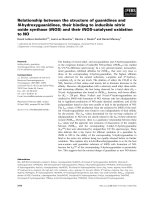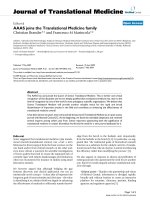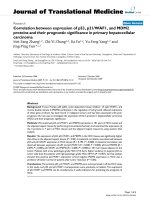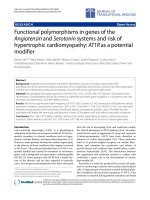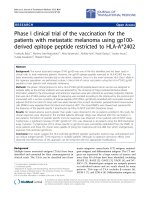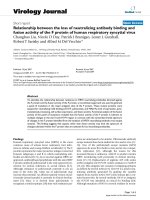Báo cáo hóa học: " Relationship between the loss of neutralizing antibody binding and fusion activity of the F protein of human respiratory syncytial virus" doc
Bạn đang xem bản rút gọn của tài liệu. Xem và tải ngay bản đầy đủ của tài liệu tại đây (229.65 KB, 4 trang )
BioMed Central
Page 1 of 4
(page number not for citation purposes)
Virology Journal
Open Access
Short report
Relationship between the loss of neutralizing antibody binding and
fusion activity of the F protein of human respiratory syncytial virus
Changbao Liu, Nicole D Day, Patrick J Branigan, Lester L Gutshall,
Robert T Sarisky and Alfred M Del Vecchio*
Address: Centocor R&D, Inc., 145 King of Prussia Road, Radnor, Pennsylvania, 19087, USA
Email: Changbao Liu - ; Nicole D Day - ; Patrick J Branigan - ;
Lester L Gutshall - ; Robert T Sarisky - ; Alfred M Del Vecchio* -
* Corresponding author
Abstract
To elucidate the relationship between resistance to HRSV neutralizing antibodies directed against
the F protein and the fusion activity of the F protein, a recombinant approach was used to generate
a panel of mutations in the major antigenic sites of the F protein. These mutant proteins were
assayed for neutralizing mAb binding (ch101F, palivizumab, and MAb19), level of expression, post-
translational processing, cell surface expression, and fusion activity. Functional analysis of the fusion
activity of the panel of mutations revealed that the fusion activity of the F protein is tolerant to
multiple changes in the site II and IV/V/VI region in contrast with the somewhat limited spectrum
of changes in the F protein identified from the isolation of HRSV neutralizing antibody virus escape
mutants. This finding suggests that aspects other than fusion activity may limit the spectrum of
changes tolerated within the F protein that are selected for by neutralizing antibodies.
Findings
Human respiratory syncytial virus (HRSV) is the most
common cause of serious lower respiratory tract infec-
tions in infants and young children worldwide [1]. The F
protein represents the major protective antigen conserved
between subgroups A and B to which neutralizing anti-
bodies are directed [2-5]. As no vaccines against HRSV are
approved, antibodybased prophylaxis with the anti-HRSV
F protein antibody palivizumab is the only approved pre-
vention for serious infections in at-risk infants [6,7].
Although resistance to palivizumab currently is not an
issue in the clinic [8], wider use of palivizumab may
increase this potential. An affinity matured version of pal-
ivizumab (motavizumab) is currently in clinical develop-
ment [9]. Since it is derived from palivizumab, it
recognizes a similar epitope [10] thus viral resistance pat-
terns are anticipated to be similar. Palivizumab antibody
escape mutants have been studied in vitro and in vivo [11-
14]. One of the palivizumab escape mutants (MP4)
appears to be more fit in both in vitro and in vivo compet-
itive replication [11], although the reason for this
increased fitness is unknown. MAb19 is another murine
HRSV neutralizing mAb previously in clinical develop-
ment [15-17]. Replacement of arginine 429 with serine
within antigenic site IV/V/VI confers resistance to MAb19
[15,18]. This antigenic site contains overlapping epitopes
as defined by several mAbs [19]. Ch101F is a potent neu-
tralizing antibody generated by grafting the variable
regions from murine mAb (101F) onto human IgG1 con-
stant frameworks. By several methods, K433 in antigenic
site IV/V/VI was identified as critical for binding [20].
Although mutation of K433 to several residues in recom-
Published: 10 July 2007
Virology Journal 2007, 4:71 doi:10.1186/1743-422X-4-71
Received: 6 June 2007
Accepted: 10 July 2007
This article is available from: />© 2007 Liu et al; licensee BioMed Central Ltd.
This is an Open Access article distributed under the terms of the Creative Commons Attribution License ( />),
which permits unrestricted use, distribution, and reproduction in any medium, provided the original work is properly cited.
Virology Journal 2007, 4:71 />Page 2 of 4
(page number not for citation purposes)
binantly expressed F protein prevented ch101F binding,
only one change (K433T) was identified by mapping of
ch101F escape mutant viruses. The same escape mutation
was reported for mAb R7.936/4 [19]. To better under-
stand the relationship between resistance to antiHRSV F
protein antibodies and F protein function, we used a
recombinant approach to generate a panel of mutations
in antigenic sites II and IV/V/VI [18] of the F protein and
characterized these mutations with respect to expression,
neutralizing mAb binding, and fusion activity as previ-
ously described [21] in an attempt to better understand
the mechanism of action of HRSV neutralizing antibodies
and the impact of resistance to these antibodies upon the
fusion activity of the F protein. A summary of these results
is presented in Table 1. The HRSV neutralizing mAbs pal-
ivizumab, MAb19, and ch101F were selected for study as
these are potent and are either marketed (palivizumab,
Synagis
®
; reviewed in [22]), have been in clinical develop-
ment (MAb19, RHZ19)[16,17,23], or are good candidates
for clinical development (ch101F)[20], respectively. They
also recognize one of the two major antigenic sites (site II
or site IV/V/VI) within the F protein, and residues in their
epitopes critical for binding have been somewhat charac-
terized.
Mutations of residues K272 and S275 (K272M, K272N,
K272Q, K272T, and S275F) reduced palivizumab binding
as expected based upon previous studies [11-14,24], yet
retained binding by MAb19 and ch101F confirming that
MAb19 and ch101F recognize a different epitope (site IV/
V/VI) than palivizumab (site II). These mutations had
fusion activity similar to or greater than WT. It is tempting
to speculate that this may partially explain the observed
increase in replicative fitness of the palivizumab escape
mutant MP4 (change of K272 to M) [11] as this mutation
had increased fusion activity (2.3 fold relative to WT).
Mutation of R429 to S reduced MAb19 binding (3.9%) as
expected based upon previous studies [15,18], yet
retained binding by palivizumab confirming that MAb19
and palivizumab recognize different epitopes. Mutation
of R429 to K similarly reduced MAb19 binding (11.2%).
Binding of ch101F to R429S was somewhat reduced
(44.6%), while binding of ch101F to R429K was largely
unaffected (72.5% relative to WT) suggesting that these
two mAbs recognize somewhat distinct epitopes. Muta-
tion of R429 to S had no effect upon fusion activity. How-
ever, interestingly, the structurally conservative mutation
of R429 to K caused a 4 fold increase in the fusion activity
Table 1: Summary of results for HRSV F mutations.
Mutation Processing Percent binding Fusion activity
ch101F palivizumab mAb19
Wild-type Complete 99.9 100.0 99.9 1.0 ± 0.0
K272M Complete 126.6 3.8 100.5 2.3 ± 0.7
K272N Complete 95.5 15.3 62.3 2.2 ± 0.5
K272Q Complete 85.3 30.1 88.7 2.6 ± 0.1
K272T Complete 70.4 9.1 68.0 1.0 ± 0.1
S275F Complete 29.4 10.9 31.7 1.6 ± 0.2
T400A Complete 155.2 126.6 161.2 2.9 ± 0.5
C422S Complete 159.6 177.5 193.9 1.6 ± 0.6
N428D Complete 116.2 139.4 121.3 0.75 ± 0.02
N428Q Complete 117.2 190.2 193.8 1.5 ± 0.02
R429K Complete 44.6 88.8 11.2 4.0 ± 0.2
R429S Complete 72.5 150.0 3.9 1.1 ± 0.1
G430A Complete 79.7 166.5 0.15 1.2 ± 0.2
I431A Complete 61.9 108.2 81.8 1.6 ± 0.3
I431L Complete 78.5 80.9 65.5 1.8 ± 0.1
I432L Complete 74.9 68.9 64.4 1.5 ± 0.2
I432Q Complete 49.3 60.8 57.9 0.7 ± 0.07
I432T Complete 191.7 206.9 169.8 1.4 ± 0.3
K433D Complete 1.1 29.9 1.6 0.4 ± 0.01
K433L Complete 3.8 88.1 24.5 0.5 ± 0.1
K433N Complete 2.9 80.7 28.7 2.2 ± 0.5
K433Q Complete 2.7 60.7 47.4 1.0 ± 0.8
K433R Complete -0.6 15.8 23.1 2.0 ± 0.6
K433T Complete 3.9 64.5 64.4 0.6 ± 0.04
K433S Complete 69.5 86.3 111.8 0.98 ± 0.19
Processing is defined as relative amounts of F0, F1, and F2, and is described as being equivalent to wild-type HRSV F protein (complete) or reduced.
Reactivity with neutralizing mAbs (palivizumab, Mab19, and ch101F) as determined by flow cytometry is reported as percent relative to wild-type
HRSV F protein. Cell fusion activity (luciferase activity) is reported relative to wild-type as described in [30]. All values are expressed as relative to
wild-type.
Virology Journal 2007, 4:71 />Page 3 of 4
(page number not for citation purposes)
of the F protein, although this mutant was not identified
during a selection of MAb19 escape mutants [15].
Previous results had identified K433 as a critical residue
for the binding of ch101F. Mutation of K433 to D, L, N,
Q, R, or T abolished ch101F binding as previously
reported [20], but, with the exception of K433D and
K433R, modest to no effects upon palivizumab binding.
These mutations also reduced the binding of MAb19 to
various degrees highlighting the complexity of antigenic
site IV/V/VI. It is interesting to note that while mutation of
K433 to threonine had such a marked effect upon ch101F
binding, mutation of K433 to the structurally similar ser-
ine had little to no effect. Mutation of K433 either
increased fusion activity (K433R, K433N), reduced it by
50% (K433D, K433L, K433T), or had little to no effect
(K433Q, K433S). Mutation K433D appeared to reduce
binding of all three mAbs suggesting that this mutation
was not efficiently expressed on the cell surface as the
other mutations, which may account for its reduced
fusion activity. Mutations T400A, C422S [21], N428D,
and N428Q around the site IV/V/VI region had no effect
upon mAb binding or fusion activity which show this is
not a region of F protein hypersensitive to mutations.
The classical approach of selecting antibody escape
mutant viruses is limited by the impact of such mutations
upon viral growth fitness, and in general, provides a much
more limited spectrum of residue changes. Antibody
escape mutants selected with ch101F revealed only a sin-
gle change in lysine residue 433 to threonine suggesting
that there are additional constraints on this region of the
protein that limit which amino acids changes are tolerated
in this region. Furthermore, the only change identified for
antibody escape mutant viruses selected with MAb19 was
a single change at R429 to S. Interestingly, it appears that
resistance to mAbs which map to antigenic site IV/V/VI
requires more passages in vitro for selection [19]; how-
ever, the relative fitness of site II and site IV/V/VI escape
mutants would need to be assessed in parallel to deter-
mine if this is true. The F protein shows a high degree of
conservation both within and between subgroup A and B,
as well as with bovine RSV. Given this high degree of con-
servation, it was somewhat surprising that the functional
analysis of the fusion activity of the panel of mutations
described here revealed that the fusion activity of the F
protein is tolerant to multiple changes in the site II and IV/
V/VI region. These changes included those identified from
the selection of mAb escape mutants as well as other resi-
due changes not identified in escape mutants. These
results suggests that aspects other than fusion activity may
limit the spectrum of changes tolerated within the F pro-
tein. Although the F protein is the only virion surface pro-
tein required for fusion and viral entry [25-27], the F
protein is also essential for the formation of mature virion
particles [26,28,29]. It is possible that the RNA sequence
of this region contains some critical function, and/or that
mutations in this region of the F protein impact some
other unknown function(s) essential for virus growth. If
these mutation affect the F protein, they would also sug-
gest that antibodies such as MAb19 and ch101F may not
neutralize virus solely by inhibition of fusion. Additional
studies may provide direct information on the mecha-
nism of action of HRSV neutralizing antibodies directed
against the F protein such as ch101F.
A thorough characterization of the epitopes on the F pro-
tein for HRSV neutralizing mAbs may provide insights
into the mechanisms of action by which mAbs against the
HRSV F protein neutralize virus as well as a better under-
standing of the mechanism by which the F protein medi-
ates cell fusion. Such studies may provide additional
insights into the function of the F protein, and help in the
selection and development of clinical candidates, such as
ch101F, for next generation antibody-based prophylaxis
and therapy for HRSV infections.
Abbreviations
HRSV Human respiratory syncytial virus
F protein fusion protein
mAb monoclonal antibody
ch101F chimeric 101F
WT wild-type
Competing interests
The authors CL, ND, PB, LG, RS, and AD declare that they
are employees of Centocor, Inc. which provided sup-
ported for this work.
Authors' contributions
CL generated reagents and performed the fusion assays.
PB and ND performed the flow cytometry. LG conducted
sitedirected mutagenesis of the HRSV F protein. AD and
RS participated in the design, oversight of the conduct of
the experiments, and interpretation of the results. All
authors have read and approved the final manuscript.
Acknowledgements
We thank Geraldine Taylor and Jose Melero for generously providing
mAb19 hybridoma supernatant, and 101F antibody, as well as helpful dis-
cussions and comments.
References
1. Stensballe LG, Devasundaram JK, Simoes EA: Respiratory syncytial
virus epidemics: the ups and downs of a seasonal virus. Pediatr
Infect Dis J 2003, 22:S21-32.
Publish with BioMed Central and every
scientist can read your work free of charge
"BioMed Central will be the most significant development for
disseminating the results of biomedical research in our lifetime."
Sir Paul Nurse, Cancer Research UK
Your research papers will be:
available free of charge to the entire biomedical community
peer reviewed and published immediately upon acceptance
cited in PubMed and archived on PubMed Central
yours — you keep the copyright
Submit your manuscript here:
/>BioMedcentral
Virology Journal 2007, 4:71 />Page 4 of 4
(page number not for citation purposes)
2. Anderson LJ, Bingham P, Hierholzer JC: Neutralization of respira-
tory syncytial virus by individual and mixtures of F and G
protein monoclonal antibodies. J Virol 1988, 62:4232-4238.
3. Beeler JA, van Wyke Coelingh K: Neutralization epitopes of the
F glycoprotein of respiratory syncytial virus: effect of muta-
tion upon fusion function. J Virol 1989, 63:2941-2950.
4. Garcia-Barreno B, Palomo C, Penas C, Delgado T, Perez-Brena P,
Melero JA: Marked differences in the antigenic structure of
human respiratory syncytial virus F and G glycoproteins. J
Virol 1989, 63:925-932.
5. Trudel M, Nadon F, Seguin C, Payment P, Talbot PJ: Respiratory
syncytial virus fusion glycoprotein: further characterization
of a major epitope involved in virus neutralization. Can J
Microbiol 1987, 33:933-938.
6. Johnson S, Oliver C, Prince GA, Hemming VG, Pfarr DS, Wang SC,
Dormitzer M, O'Grady J, Koenig S, Tamura JK, Woods R, Bansal G,
Couchenour D, Tsao E, Hall WC, Young JF: Development of a
humanized monoclonal antibody (MEDI-493) with potent in
vitro and in vivo activity against respiratory syncytial virus. J
Infect Dis 1997, 176:1215-1224.
7. Feltes TF, Cabalka AK, Meissner HC, Piazza FM, Carlin DA, Top FH
Jr., Connor EM, Sondheimer HM: Palivizumab prophylaxis
reduces hospitalization due to respiratory syncytial virus in
young children with hemodynamically significant congenital
heart disease. J Pediatr 2003, 143:532-540.
8. DeVincenzo JP, Hall CB, Kimberlin DW, Sanchez PJ, Rodriguez WJ,
Jantausch BA, Corey L, Kahn JS, Englund JA, Suzich JA, Palmer-Hill FJ,
Branco L, Johnson S, Patel NK, Piazza FM: Surveillance of clinical
isolates of respiratory syncytial virus for palivizumab (Syna-
gis)-resistant mutants. J Infect Dis 2004, 190:975-978.
9. Wu H, Pfarr DS, Johnson S, Brewah YA, Woods RM, Patel NK, White
WI, Young JF, Kiener PA: Development of motavizumab, an
ultra-potent antibody for the prevention of respiratory syn-
cytial virus infection in the upper and lower respiratory
tract. J Mol Biol 2007, 368:652-665.
10. Young JF, Koenig S, Johnson LS: Anti-RSV Antibodies. USA, Med-
Immune, Inc.; 2004.
11. Zhao X, Liu E, Chen FP, Sullender WM: In vitro and in vivo fitness
of respiratory syncytial virus monoclonal antibody escape
mutants. J Virol 2006, 80:11651-11657.
12. Zhao X, Sullender WM: In vivo selection of respiratory syncytial
viruses resistant to palivizumab. J Virol 2005, 79:3962-3968.
13. Zhao X, Chen FP, Megaw AG, Sullender WM: Variable resistance
to palivizumab in cotton rats by respiratory syncytial virus
mutants. J Infect Dis 2004, 190:1941-1946.
14. Zhao X, Chen FP, Sullender WM: Respiratory syncytial virus
escape mutant derived in vitro resists palivizumab prophy-
laxis in cotton rats. Virology 2004, 318:608-612.
15. Taylor G, Stott EJ, Furze J, Ford J, Sopp P: Protective epitopes on
the fusion protein of respiratory syncytial virus recognized
by murine and bovine monoclonal antibodies. J Gen Virol 1992,
73 ( Pt 9):2217-2223.
16. Everitt DE, Davis CB, Thompson K, DiCicco R, Ilson B, Demuth SG,
Herzyk DJ, Jorkasky DK: The pharmacokinetics, antigenicity,
and fusion-inhibition activity of RSHZ19, a humanized mon-
oclonal antibody to respiratory syncytial virus, in healthy vol-
unteers. J Infect Dis 1996, 174:463-469.
17. Wyde PR, Moore DK, Hepburn T, Silverman CL, Porter TG, Gross
M, Taylor G, Demuth SG, Dillon SB: Evaluation of the protective
efficacy of reshaped human monoclonal antibody RSHZ19
against respiratory syncytial virus in cotton rats. Pediatr Res
1995, 38:543-550.
18. Arbiza J, Taylor G, Lopez JA, Furze J, Wyld S, Whyte P, Stott EJ,
Wertz G, Sullender W, Trudel M, et al.: Characterization of two
antigenic sites recognized by neutralizing monoclonal anti-
bodies directed against the fusion glycoprotein of human
respiratory syncytial virus. J Gen Virol 1992, 73 ( Pt
9):2225-2234.
19. Lopez JA, Bustos R, Orvell C, Berois M, Arbiza J, Garcia-Barreno B,
Melero JA: Antigenic structure of human respiratory syncytial
virus fusion glycoprotein. J Virol 1998, 72:6922-6928.
20. Wu SJ, Schmidt A, Beil EJ, Day ND, Branigan PJ, Liu C, Gutshall LL,
Palomod C, Furze J, Taylor G, Melero JA, Tsui P, Del Vecchio AM,
Kruszynski M: Characterization of the epitope for anti human
respiratory syncytial virus F protein monoclonal antibody
101F using synthetic peptides and genetic approaches. J Gen
Virol submitted:.
21. Day ND, Branigan PJ, Liu C, Gutshall LL, Luo J, Melero JA, Sarisky RT,
Del Vecchio AM: Contribution of cysteine residues in the
extracellular domain of the F protein of human respiratory
syncytial virus to its function. Virol J 2006, 3:34.
22. Cardenas S, Auais A, Piedimonte G: Palivizumab in the prophy-
laxis of respiratory syncytial virus infection. Expert Rev Anti
Infect Ther 2005, 3:719-726.
23. Johnson S, Griego SD, Pfarr DS, Doyle ML, Woods R, Carlin D, Prince
GA, Koenig S, Young JF, Dillon SB: A direct comparison of the
activities of two humanized respiratory syncytial virus mon-
oclonal antibodies: MEDI-493 and RSHZl9. J Infect Dis 1999,
180:35-40.
24. Crowe JE, Firestone CY, Crim R, Beeler JA, Coelingh KL, Barbas CF,
Burton DR, Chanock RM, Murphy BR: Monoclonal antibody-
resistant mutants selected with a respiratory syncytial virus-
neutralizing human antibody fab fragment (Fab 19) define a
unique epitope on the fusion (F) glycoprotein. Virology 1998,
252:373-375.
25. Karron RA, Wright PF, Crowe JE Jr., Clements-Mann ML, Thompson
J, Makhene M, Casey R, Murphy BR: Evaluation of two live, cold-
passaged, temperature-sensitive respiratory syncytial virus
vaccines in chimpanzees and in human adults, infants, and
children. J Infect Dis 1997, 176:1428-1436.
26. Teng MN, Collins PL: Identification of the respiratory syncytial
virus proteins required for formation and passage of helper-
dependent infectious particles. J Virol 1998, 72:5707-5716.
27. Teng MN, Whitehead SS, Collins PL: Contribution of the respira-
tory syncytial virus G glycoprotein and its secreted and
membrane-bound forms to virus replication in vitro and in
vivo. Virology 2001, 289:283-296.
28. Techaarpornkul S, Barretto N, Peeples ME: Functional analysis of
recombinant respiratory syncytial virus deletion mutants
lacking the small hydrophobic and/or attachment glycopro-
tein gene. J Virol 2001, 75:6825-6834.
29. Techaarpornkul S, Collins PL, Peeples ME: Respiratory syncytial
virus with the fusion protein as its only viral glycoprotein is
less dependent on cellular glycosaminoglycans for attach-
ment than complete virus. Virology 2002, 294:296-304.
30. Branigan PJ, Liu C, Day ND, Gutshall LL, Sarisky RT, Del Vecchio AM:
Use of a novel cell-based fusion reporter assay to explore the
host range of human respiratory syncytial virus F protein.
Virol J 2005, 2:54.
